|
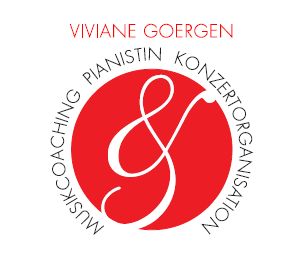 |
||||||||||||||
|
R E Z E N Z I O N E N |
||||||||||||||
|
Pianonews, Magazin für Klavier und Flügel Heft 6/2025 Staccato Verlag https://www.pizzicato.lu/viviane-goergen-prasentiert-buch-uber-die-komponistin-marie-jaell/ https://www.hr2.de/podcasts/musikland-hessen--jaell---eine-ganz-grosse-ihrer-zeit,audio-111844.html Kritik zur Matinée Marie Jaëll mit Viviane Goergen, Pianistin, vom 15. Mai 2022 in Zusammenarbeit mit der Stiftung zur Förderung der internationalen wissenschaftlichen Beziehungen der Goethe Universität Frankfurt/Mai in der Gästevilla der Goethe Universität Viviane Goergens Spiel begeisterte erneut wie vor der coronabedingten Auftrittspause. Ihre pianistischen Möglichkeiten füllen die gesamte Bandbreite vom empfindsamsten Pianissimo bis zum donnernden Grollen aller himmlischen wie höllischen Elementarkräfte, vom vorsichtig-zaghaften, befragenden Anklopfen bis zur fast brachialen Expression. Den an technischen Finessenen den schwierigsten Werken etwa eines Franz Liszt nicht nachstehenden Anforderungen der Komponistin begegnet sie mit Souveränität. In Marie Jaëll scheint sie sogar ihr kongeniales kompositorisches Gegenüber gefunden zu haben, geradezu in Seelenverwandschaft ihr verbunden zu sein. Wunderbar zu hören, wie sie ebenso mit dem scheinbar leichteren“ Genre Jaëlls umgeht, etwa den Valses mignonnes, von denen sie die Walzer Nr. 4 in d-moll (Très décidé) und Nr. 3 in G-Dur (Mouvement très modéré) als Zugaben zum besten gibt. Fesselnd schließlich auch ihre Art und Weise, ihre Musik mit einigen Erläuterungen zu begleiten.Erhard Metz www.feuilletonfrankfurt.de Matinee Marie Jaell /Viviane Goergen Die Fähigkeit, innig-sanfte Gefühlsbilder sensibel zu gestalten, zeigte sich im Laufe des Abends als Stärke von Viviane Goergen. In Reflets dans l’Eau“ und in Hommage à Rameau“ aus Debussys Images“ ließ sie eine vielfältige Farbenpalette aufleuchten. Rhythmisch differenziert, klar strukturiert klang auch Debussys L’Isle Joyeuse“. Vom poetischen Ausdruck in Des Abends“ über das sanfte Fragen in Warum“ und die innere Unruhe des In der Nacht“ bis hin zum akkordisch - orchestralen, kapriziösen Ende vom Lied“ in Schumanns Fantasie Stücke op. 12 – Viviane Goergen traf stets die richtige Atmosphäre. Frankfurter Allgemeine Zeitung Durch packende Virtuosität, glasklare Anschlagdelikatesse und akribische Genauigkeit gab Viviane Goergen den verschiedenartigen Affekten bedachten Kompositionen Leben und Fülle, so dass die farbigen Phantasien und Visionen von Scarlattis Sonaten transparent wurden und vom ersten bis zum letzten Ton unter dynamischer Spannung standen. Die Sonate op. 10 Nr. 3 von Ludwig van Beethoven gilt als sein phantasievollstes und pianistisch wirkungsstärkstes Werk. Viviane Goergen interpretierte die Sonate mit traumwandlerischer Sicherheit und absoluter Werkbeherrschung und verblüffte durch ihr nuancenreiches und ausgeklügeltes Spiel. Weitab von Effekthascherei gestaltete sie die wenig gehörte Sonate mit kraftvollem Pathos und souveräner Spieltechnik zu einer Kostbarkeit Beethovenscher Schöpfungen, aufwühlend im düsteren Largo, erlösend und lebensbejahend im Menuett, scherzend und übermütig im Rondo. Badische Zeitung Gelöster, klangfarbiger, ausdrucksvoller können sich diese fremden Länder, diese kuriosen Geschichten, diese Träumereien, dieser Ritter auf dem Steckenpferd usw. nicht anhören. Florestan und Eusebius, die geistigen Kinder Robert Schumanns, hat Viviane Goergen adoptiert“ und sie dem geneigten Publikum eigens vorgetragen – einem Publikum von Davidsbündlern, wie sich denken lässt. Florestan und Eusebius eroberten sich an diesem Abend alle Herzen. Und wie Kinder im Marionettentheater die Hand vergessen, die die Fäden führt, so vergaßen wir an diesem Abend die Hände der Pianistin und überließen uns ganz dem poetischen Zauber der Schumannschen Musik. Ein besseres Kompliment können wir u. E. der Kunst Viviane Goergens nicht machen als das, dass sie uns über der Musik, die sie spielte, uns und sie selbst vergessen ließ! Luxemburger Wort Viviane Goergen champions the music of nine women in an interesting and engaging recital containing music of much beauty and interest
Piano Miniatures by Female Composers The music of women composers is finally being given the respect and credit it deserves. However, the fact that this disc presents music of nine composers of whom hardly any are well known, shows that there is still a long way to go. That the ARS label has released this disc should be both applauded and condemned: applauded, in that they bring to the listening public a cross section of composers from the nineteenth and twentieth centuries, and condemned because it takes a disc of âPiano Miniatures by Female Composersâ™ for them to be recognised, which begs the question of why they have not previously been included on discs of piano pieces by their male contemporaries. This is something of which the whole industry seems to be guilty, there seldom being examples of male and female composers sharing the limelight and, in the past, just the odd piece being included as a filler. The major labels have been especially bad at this, so grateful thanks go to ARS for this fine disc. Noch immer wird vom Anteil und der Rolle der Frauen in der Musikgeschichte kaum Notiz genommen, ein unterbewertetes Thema. Im Bereich Klavierrepertoire hat Viviane Goergen Pianistische Miniaturen vonKomponistinnen“ vor allem des 20. Jahrhunderts recherchiert (s. den Begleittext) und manches Verblüffende entdeckt. So das expressive Grave majestueux aus La cathédrale blessée) von Mel Bonis, deren Akkord-Trauer und Klage berührend sind. Als pittoresken Tanz gestaltet Viviane Goergen die kapriziösen Jeux de Nymphes“ von Marguerite Roesgen-Champion und wie einen springenden Kobold die « Humoreska“ der Tschechin Ottilie Sukova-Dvorakova, Antonin Dvoraks Tochter. Ein Sujet, das bei Marie Jaell in den Valses Mignonnes“ zum kauzigen Stil und bei Vera Winogradovas Deux- danses“ zur Groteske mutiert. Außerdem ist Sicilienne“ von Germaine Tailleferre als flimmerndes Stillleben, moderne Nervosität inzuckendem Duktus in den April-Präludien“ von Vitzeslava Kapra-ova und der Marsch aus den Cinq Miniatures“ von Stefanie Zaranekwie frecher Spott zu hören. Nur Alicia Terzian lässt im folkloristischen Danza Criola“ zu, dass man träumen kann. Sicher ist, dass die Werke der genannten neun Komponistinnen aus Frankreich, der Schweiz, Tschechien, Russland und Argentinien, um die sich Viviane Goergen mit kompetentem Engagement für diese Aufnahme gekümmert hat, Originalität vorweisen können. Hans-Dieter Grünefeld Pianistische Miniaturen von Komponistinnen Werke von Mel Bonis u. a. Viviane Goergen, Klavier (k. A.) Ars Produktion 38559 (Vertrieb: Note 1)
Marie Jaëll: Von Himmel und Hölle
Die luxemburgisch-schweizerische Pianistin Viviane Goergen bringt mit Piéces pour piano d’aprés une lecture de Dante von Marie Jaëll (1846-1925) ein Album auf den Markt, das der unbequemen und herausfordernden Musik der Komponistin Hochachtung zollt. Denn einfach ist dieses dreiteilige Wer´Ce qu’on entend dans l’enfer’, ´Ce qu’on entend dans le purgatoire’ und ´Ce qu’on entend dans le paradis’ (‘Was man in der Hölle hört’‘ Was man im Fegefeuer hört’ und ´Was man im Paradies hört’) nicht und fordert von Hörer allerhöchste Konzentration. Die drei mal sechs Klavierstücke von je rund vier Minuten Spieldauer erschließen sich einem nur langsam. Jaëll war ihrer Zeit deutlich voraus. Als Schülerin von Saint-Saëns und Franck ging sie ganz eigene Wege, tatkräftig unterstützt von ihrem Mentor und Freund Franz Liszt. Diese Klavierstücke in Anlehnung an Dantes Göttliche Komödie wurden 1894 komponiert und sind das letzte große Werk der Komponistin, die sich ab dann der musikwissenschaftlichem Forschung zuwandte. Marie Jaëll galt neben ihrer Kompositionstätigkeit als eine überragende Klaviervirtuosin. Viviane Goergen spielt diese 18 Klavierstücken sehr analytisch und präzise. Wenn man anfangs dann auch einen emotionalen Gehalt vermisst, so wird doch schnell klar, dass Goergens stukturbetonte Interpretation die verschiedenen Stimmungen und Farben des Werkes doch sehr gut wiedergibt. Viviane Goergen überzeugt letztendlich den Hörer durch eine sehr gut vorbereitete, klanglich wie stilistisch wohl ausbalancierte und in jedem Moment packende Wiedergabe, der Objektivität zwar eine gewisse Distanz zur Musik schafft, sie aber gerade dadurch sehr deutlich und mit klaren architektonischen Linien erleben lässt. With Pièces pour piano d’après une lecture de Dante by Marie Jaëll (1846-1925), Luxembourgian-Swiss pianist Viviane Goergen releases an album that pays tribute to the composer’s uncomfortable and challenging music. The three-part work « Ce qu’on entend dans l’enfer », « Ce qu’on entend dans le purgatoire » and « Ce qu’on entend dans le paradis » (« What one hears in hell », « What one hears in purgatory » and « What one hears in paradise ») is not easy and requires the listener’s utmost concentration. The three times six piano pieces, each about four minutes long, reveal themselves only slowly. Jaëll was clearly ahead of her time. A student of Saint-Saëns and Franck, she went her own way, actively supported by her mentor and friend Franz Liszt. These piano pieces, based on Dante’s Divine Comedy, were composed in 1894 and are the last major works of the composer, who then turned to musicological research. In addition to her compositional activities, Marie Jaëll was considered an outstanding piano virtuoso. Viviane Goergen plays these 18 piano pieces very analytically and precisely. Even if one initially misses an emotional content, it soon becomes clear that Goergen’s interpretation, which emphasizes the structure, reproduces the various moods and colors of the work very well. Viviane Goergen convinces the listener with a very well-prepared, tonally and stylistically well-balanced performance that is gripping at every moment, creating a certain distance to the music, but allowing it to be experienced very clearly and with clear architectural lines. https://www.pizzicato.lu/marie-jaell-von-himmel-und-holle/
SR2RadioKultur "Album der Woche" 18 Klavierstücken von Marie Jaëll, Viviane Goergen Pianistin "Zwei faszinierende Frauen begegnen uns im Album der Woche, die Link zum Interview mit Viviane Goergen beim SR2Radiokultur/ Gutierrez Goergen Jaëll "Album der Woche" Marie Jaëll de l'Alsace á l'Europe Marie Jaëll. Pieces pour piano Ce qu’on entend dans I’enfer, le purgatoire, le paradis, par Viviane Goergen, piano
(Haenssler Classic, 2024). Troubadour-Forum Marie Jaell: 18 Klavierstücke uhrand@uhrand 712 Beiträge Themengebiet Lied #1 · 3. März 2024, 11:25 1870 konzentriert sich die Französin Marie Jaëll auf die Komposition. Sie nimmt Unterricht bei César Franck und Camille Saint-Saëns. Franz Liszt unterstützt ihre Arbeit, veröffentlicht ihre Kompositionen und spielt sie in Konzerten. Er schreibt: »Der Name eines Mannes auf ihrer Musik und sie wird auf jedem Klavier gespielt werden.« Von 1883 bis 1886 kommt Marie Jaëll für sechs Monate im Jahr zu Liszt nach Weimar. Sie korrigiert seine Kompositionen und kümmert sich um seine Korrespondenz. Zwischen den beiden entwickelt sich eine tiefe Freundschaft. Liszt schreibt: »Sie hat den Geist eines Philosophen und die Hände eines Künstlers«. Ihr achtzehn Klavierstücke sind sehr ausdrucksstark, aber auch sehr anspruchsvoll, also nicht so leicht zugänglich für alle. Mehrfaches Anhören mag durchaus erforderlich sein, um sich mit ihrem Stil erstmal anzufreunden. Ce qu’on entend dans l’Enfer (Was man in der Hölle hört)
« FEMMES À L’HONNEUR » : BOULANGER – JAËLL
Hänssler Classic ( HC 24004) propose 18 pièces pour piano d’après la lecture de Dante (1894) de Marie Jaëll (1846-1925). Enfant prodige, elle a fait un passage éclair au conservatoire, une carrière stupéfiante en tant que pianiste ainsi qu’avec son mari, Alfred Jaëll, virtuose lui aussi. Si talentueuse, elle pouvait interpréter le répertoire de ce diable de Liszt ! Elle a énormément composé, c’est ce qu’elle préférait. Si elle avait eu un nom d’homme elle aurait été sur tous les pianos dixit Franz Liszt ! Elle a écrit une méthode de piano qu’elle a intitulé Le Toucher et qu’il est important de connaître pour bien jouer ses pièces. C’est une manière très particulière d’aborder son uvre. Tout ce qui est inconscient est imperfectible disait-elle – les sciences neuropsy étaient très à la mode à l’époque – Savoir comment préparer ses mains pour exprimer ce langage des sons, cette prise de conscience entre le, la, pianiste à son instrument, trouver une résonnance plus profonde tels sont les enseignements que voulait donner cette compositrice très originale. Viviane Goergen , se consacre depuis longtemps à la redécouverte de compositrices importantes du début du XXème siècle et donc de Marie Jaëll . Elle s’est plongée, doigts les premiers, dans ces pièces découpées en trois chapitres d’après Dante : L’Enfer, Le Purgatoire et Le Paradis. Qu’entend-on dans ces trois univers ? Telle est la question que s’est posée musicalement Jaëll. C’est avec une discipline nécessaire, une remise en question de sa manière de jouer du piano que la pianiste Goergen a abordé ces compositions. Malgré les difficultés pianistiques, la compréhension de ce que veut exprimer l Marie Jaëll, le résultat est à la hauteur du défi que s’est lancé cette magnifique artiste. Ce disque est pratiquement le seul qui existe sur le marché ! Indispensable donc pour tout amateur de musique classique. Un must! PS le livret est très intéressant sur Jaëll /Goergen Jour de colère und douceur angélique Bla Bla Blog La pianiste luxembourgo-suisse Viviane Goergen reprend cette uvre rare venue d’une des compositrices laissée justement au purgatoire musical après sa morte en 1925, avant d’être redécouverte ces dernières années, à la faveur d’une vague féministe bienvenue. …Nous avons là une plongée passionnante dans une uvre singulière qui prouve que Marie Jaëll a sa place parmi les artistes ayant leur place dans l’histoire de la musique. Viviane Goergen traduit bien cette gravité inquiétante dans l’expressionniste "Poursuite" de L’enfer. L’interprétation est précise et renvoie à la période romantique que chérissait celle qui avait les oreilles de Liszt et qui a été une interprétation reconnue des uvres de Robert Schumann ou de Beethoven. Pour autant, comme le précise l’interprète, c’est plutôt du côté du Moyen Âge qu’il faut chercher les influences de la compositrice. Pour cette "Poursuite" dans les enfers, "Marie Jaëll emploie les autre premières notes du Dies Irae, la journée de la colère… Il s’agit d’un hymne du moyen âge, écrit vers 1250", est-il écrit dans le livret de l’album. Tout aussi inquiétant et expressif, "Raillerie" a ce souffle moderne qui nous ferait presque entendre les rires du diable dans ce qui traduit "l’errance désespérée de Dante", avant cet "Appel" lugubre que la plus "jaëllienne" des pianistes fait résonner avec un malin plaisir. Qui dit enfer dit flammes. La partie qui leur est consacrée semble briller de mille feux, à telle enseigne que l’on croirait qu’il s’agit plus de feux paisibles d’une nuit fraîche d’été que des tourments de l’enfer. Dans cette uvre datant de 1894, il semble aussi que ce sont les derniers éclairs du romantisme que fait surgir Marie Jaëll. Dire que la modernité a sa place serait un pléonasme Deux morceaux incroyables viennent conclure ce délicieux Enfer, à savoir "Blasphèmes" et "Sabbat". Il s’agit de deux pièces diaboliques à la très grande modernité. Il faut toute la technicité de Viviane Goergen pour arriver à en retranscrire l’esprit diabolique, la noirceur mais aussi une forme de grâce à la fois joueuse, moqueuse et séduisante. Ne verrait-on pas une de ces Vampirella tournant autour de damnés perdus et condamnés à un enfer éternel ? Interrogeons-nous ensuite sur Ce qu’on entend dans le purgatoire. Marie Jaëll et Viviane Goergen nous le disent en musique et au piano. Il y a ces délicats "Pressentiments". On croirait entendre des murmures. Marie Jaëll n’emploie que les deux premières notes du Dies Irae dont il a été question plus haut. Les notes s’effacent presque, laissant place au silence interrogateur. On sent l’influence de Bach dans cette superbe composition. Tout aussi en retenue, les "Désirs impuissants" se jouent des ruptures de rythmes. Dire que la modernité a sa place serait un pléonasme. Dans "Alanguissement", c’est le romantisme qui semble sortir du bois. Sommes-nous ici au purgatoire ou juste sur terre, dans une campagne verdoyante où, allongés sur l’herbe, nous attendrions l’être aimé ? Séduisant purgatoire, à dire vrai, et que Viviane Goergen magnifie avec tendresse. Elle se fait par contre plus sombre et inquiétante dans "Maintenant et jadis". Les menaces grondent, tout comme les questionnements sur le pesage des âmes. Bien et mal semblent se disputer dans cette partie à la facture là aussi romantique, jusqu’aux dernières notes sombres. Béatrice apparaît mais Dante doit retourner au purgatoire, purgatoire qui se termine par une "Obsession" traduite avec une belle expressivité et demandant à Viviane Goergen une virtuosité évidente. Cette partie a été construite comme une sonate en trois mouvements – vif-lent-vif –, la section lente ayant l’allure d’un retour de la paix intérieure, avant que l’"Obsession" ne revienne définitivement. C’est le Paradis qui vient clore ce programme. Après l’Enfer et le Purgatoire, vient un "Apaisement" bienvenu, Béatrice venant guider Dante tout en haut, dans un lieu idyllique. Pour autant, l’auditeur, sera en droit d’y entendre une longue plainte autant qu’un appel à l’espérance. Les "Voix célestes" des anges qui suivent frappent par leur singulière douceur, traduisent la paix divine. L’harmonie et la douceur dominent dans ce morceau où l’on sent l’influence de Fauré. Plus qu’ailleurs sans doute, Marie Jaëll s’impose comme une figure marquante du classicisme français de la fin du XIXe et du du début du XXe siècle. Dans « "Hymne", la compositrice se révèle comme une mélodiste hors -pair, au service d’un morceau aérien atteignant des sommets de légèreté – rien d’étonnant pour Ce qu’on entend dans le paradis. La pièce "Quiétude" s’enchaîne naturellement, tout aussi gracieuse et légère. Viviane Goergen fait vibrer chaque note avec la même délicatesse. Rien de trop dans ce morceau qui ressemble à une berceuse. "Souvenance", onirique et méditatif se déploie avec une belle harmonie. On a peine à croire que peu de temps auparavant l’auditeur était entouré des flammes de l’enfer. Ici, le paradis n’est que douceur mélancolique et contemplations, dans une facture romantique . C’est d’ailleurs par une "Contemplation" que se termine Ce qu’on entend dans l’enfer, le purgatoire, le paradis. L’harmonie vient conclure la rencontre entre Dante et Béatrice et finalement la montée vers le paradis. Ces Pièces pour piano constituent un voyage vers l'au-delà imaginé, composé et interprété avec une singulière grâce. Marie Jaëll, Pièces pour piano, Viviane Goergen (piano), Hänssler Classics, 2024 Bruno Chiron
|
||||||||||||||










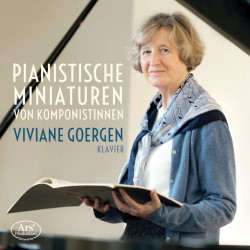
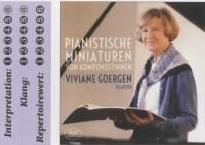
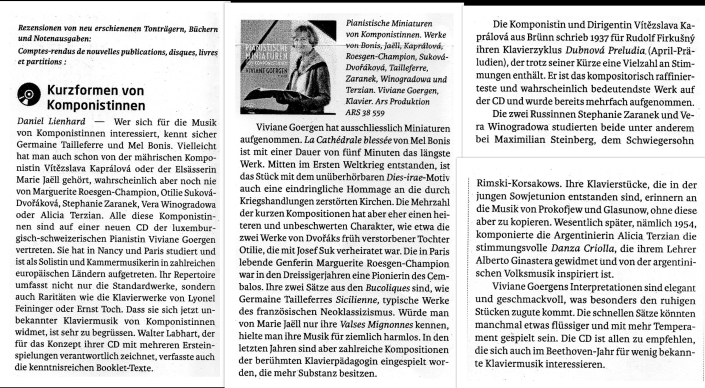
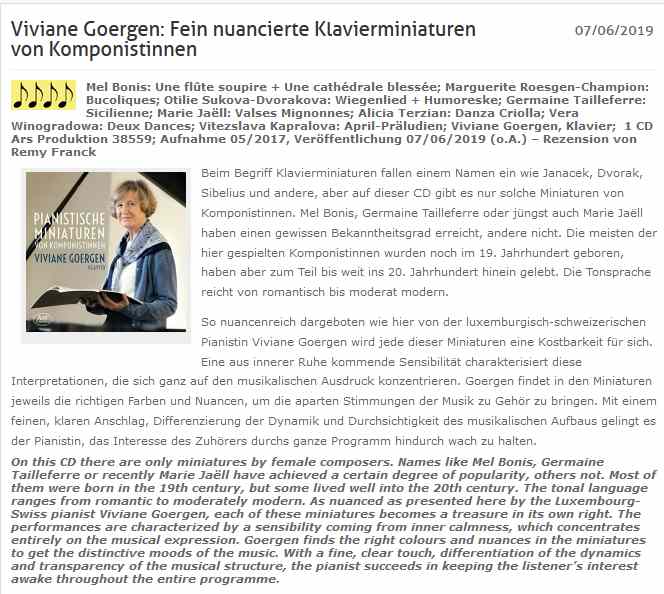
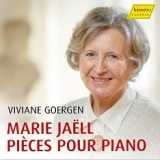

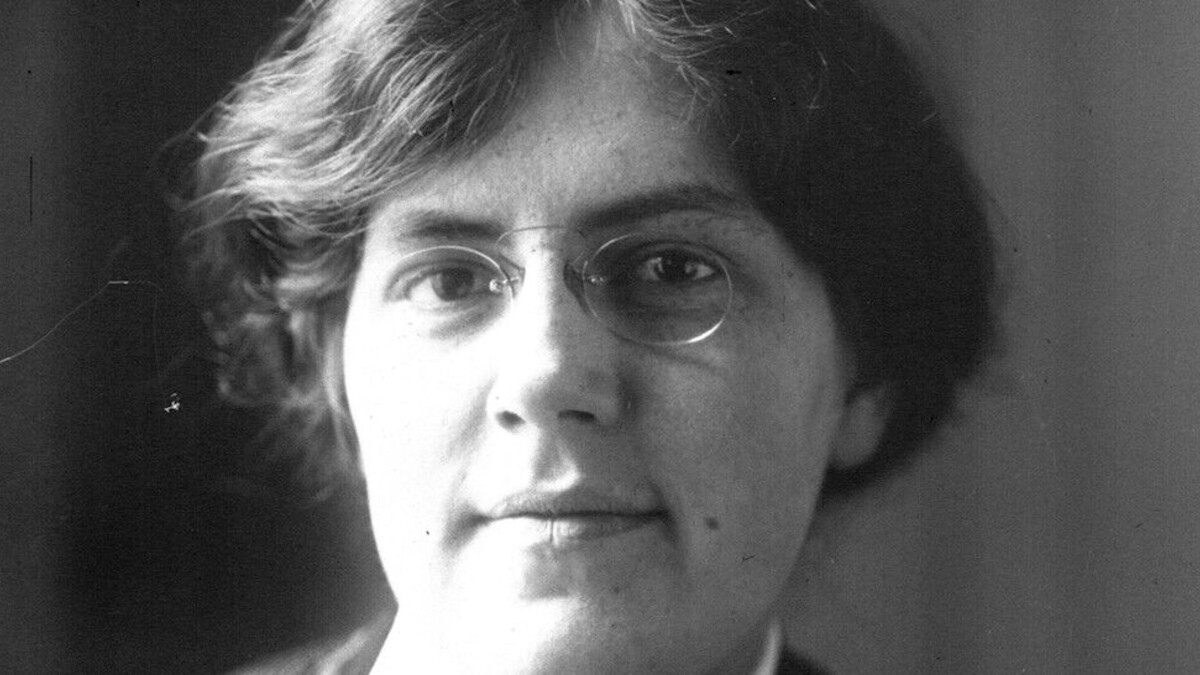 Depuis quelques temps et quel que soit leur talent, on ressuscite des compositrices. C’est devenu presque obligatoire, d’avoir en
concert, en récital, une uvre de Chaminade, Bonis, Sohy, Mendelssohn, Monk, Tailleferre, Viardo, Boulanger, etc. etc…Certaines
ont quand même résisté à la misogynie ambiante comme Schumann, Jolas, Goubaïdoulina, Saariaho, Unsuk. Sous les doigts de Vivian Goergen, pianiste luxembourgeoise-suisse,
Depuis quelques temps et quel que soit leur talent, on ressuscite des compositrices. C’est devenu presque obligatoire, d’avoir en
concert, en récital, une uvre de Chaminade, Bonis, Sohy, Mendelssohn, Monk, Tailleferre, Viardo, Boulanger, etc. etc…Certaines
ont quand même résisté à la misogynie ambiante comme Schumann, Jolas, Goubaïdoulina, Saariaho, Unsuk. Sous les doigts de Vivian Goergen, pianiste luxembourgeoise-suisse,